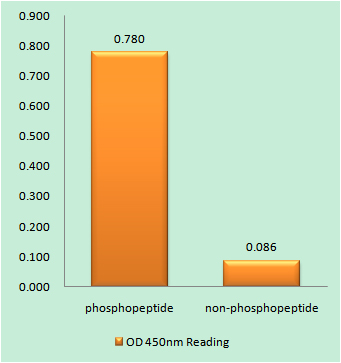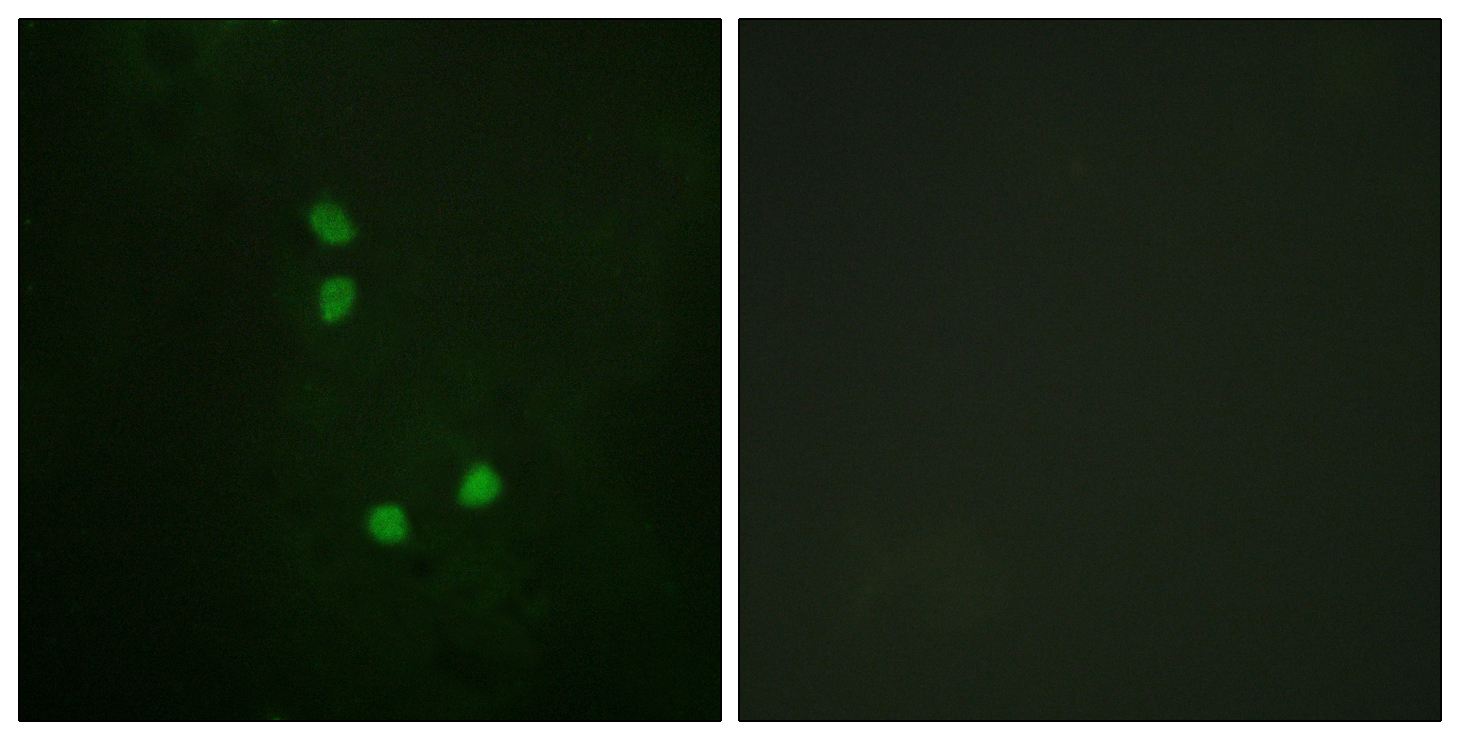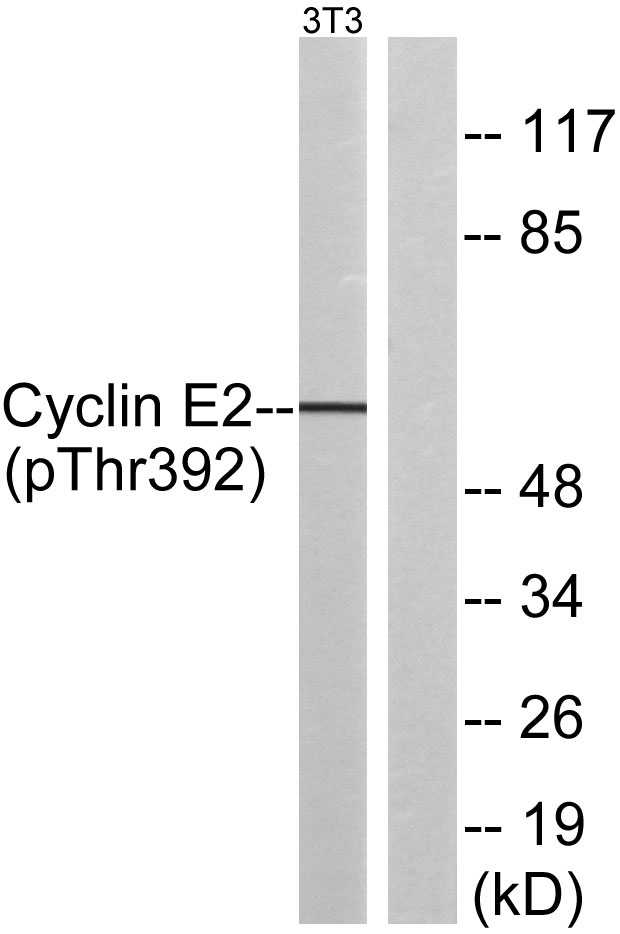Cyclin E2 (phospho Thr392) Polyclonal Antibody
- Catalog No.:YP1173
- Applications:IF;ELISA
- Reactivity:Human;Mouse
- Target:
- Cyclin E2
- Fields:
- >>Cell cycle;>>Oocyte meiosis;>>p53 signaling pathway;>>PI3K-Akt signaling pathway;>>Cellular senescence;>>Cushing syndrome;>>Hepatitis B;>>Measles;>>Human papillomavirus infection;>>Human T-cell leukemia virus 1 infection;>>Epstein-Barr virus infection;>>Pathways in cancer;>>Viral carcinogenesis;>>MicroRNAs in cancer;>>Prostate cancer;>>Small cell lung cancer;>>Gastric cancer
- Gene Name:
- CCNE2
- Protein Name:
- G1/S-specific cyclin-E2
- Human Gene Id:
- 9134
- Human Swiss Prot No:
- O96020
- Mouse Gene Id:
- 12448
- Mouse Swiss Prot No:
- Q9Z238
- Immunogen:
- The antiserum was produced against synthesized peptide derived from human Cyclin E2 around the phosphorylation site of Thr392. AA range:355-404
- Specificity:
- Phospho-Cyclin E2 (T392) Polyclonal Antibody detects endogenous levels of Cyclin E2 protein only when phosphorylated at T392.
- Formulation:
- Liquid in PBS containing 50% glycerol, 0.5% BSA and 0.02% sodium azide.
- Source:
- Polyclonal, Rabbit,IgG
- Dilution:
- IF 1:200 - 1:1000. ELISA: 1:10000. Not yet tested in other applications.
- Purification:
- The antibody was affinity-purified from rabbit antiserum by affinity-chromatography using epitope-specific immunogen.
- Concentration:
- 1 mg/ml
- Storage Stability:
- -15°C to -25°C/1 year(Do not lower than -25°C)
- Other Name:
- CCNE2;G1/S-specific cyclin-E2
- Molecular Weight(Da):
- 47kD
- Background:
- The protein encoded by this gene belongs to the highly conserved cyclin family, whose members are characterized by a dramatic periodicity in protein abundance through the cell cycle. Cyclins function as regulators of CDK kinases. Different cyclins exhibit distinct expression and degradation patterns which contribute to the temporal coordination of each mitotic event. This cyclin forms a complex with and functions as a regulatory subunit of CDK2. This cyclin has been shown to specifically interact with CIP/KIP family of CDK inhibitors, and plays a role in cell cycle G1/S transition. The expression of this gene peaks at the G1-S phase and exhibits a pattern of tissue specificity distinct from that of cyclin E1. A significantly increased expression level of this gene was observed in tumor-derived cells. [provided by RefSeq, Jul 2008],
- Function:
- function:Essential for the control of the cell cycle at the late G1 and early S phase.,induction:Activated by papilloma viral oncoproteins E6 and E7 which bind to and inactivate p53 and Rb, respectively.,PTM:Phosphorylation by CDK2 triggers its release from CDK2 and degradation via the ubiquitin proteasome pathway.,similarity:Belongs to the cyclin family.,similarity:Belongs to the cyclin family. Cyclin E subfamily.,subunit:Interacts with the CDK2 (in vivo) and CDK3 (in vitro) protein kinases to form a serine/threonine kinase holoenzyme complex. The cyclin subunit imparts substrate specificity to the complex.,tissue specificity:According to PubMed:9858585: highest levels in adult testis, thymus and brain. Lower levels in placenta, spleen and colon. Consistently elevated levels in tumor-derived cells compared to non-transformed proliferating cells. According to PubMed:9840927: low levels i
- Subcellular Location:
- Nucleus .
- Expression:
- According to PubMed:9858585, highest levels of expression in adult testis, thymus and brain. Lower levels in placenta, spleen and colon. Consistently elevated levels in tumor-derived cells compared to non-transformed proliferating cells. According to PubMed:9840927: low levels in thymus, prostate, brain, skeletal muscle, and kidney. Elevated levels in lung. According to PubMed:9840943 highly expressed in testis, placenta, thymus and brain. In a lesser extent in small intestine and colon.
- June 19-2018
- WESTERN IMMUNOBLOTTING PROTOCOL
- June 19-2018
- IMMUNOHISTOCHEMISTRY-PARAFFIN PROTOCOL
- June 19-2018
- IMMUNOFLUORESCENCE PROTOCOL
- September 08-2020
- FLOW-CYTOMEYRT-PROTOCOL
- May 20-2022
- Cell-Based ELISA│解您多样本WB检测之困扰
- July 13-2018
- CELL-BASED-ELISA-PROTOCOL-FOR-ACETYL-PROTEIN
- July 13-2018
- CELL-BASED-ELISA-PROTOCOL-FOR-PHOSPHO-PROTEIN
- July 13-2018
- Antibody-FAQs
- Products Images

- Enzyme-Linked Immunosorbent Assay (Phospho-ELISA) for Immunogen Phosphopeptide (Phospho-left) and Non-Phosphopeptide (Phospho-right), using Cyclin E2 (Phospho-Thr392) Antibody

- Immunofluorescence analysis of NIH/3T3 cells, using Cyclin E2 (Phospho-Thr392) Antibody. The picture on the right is blocked with the phospho peptide.

- Western blot analysis of Cyclin E2 (Phospho-Thr392) Antibody. The lane on the right is blocked with the Cyclin E2 (Phospho-Thr392) peptide.



